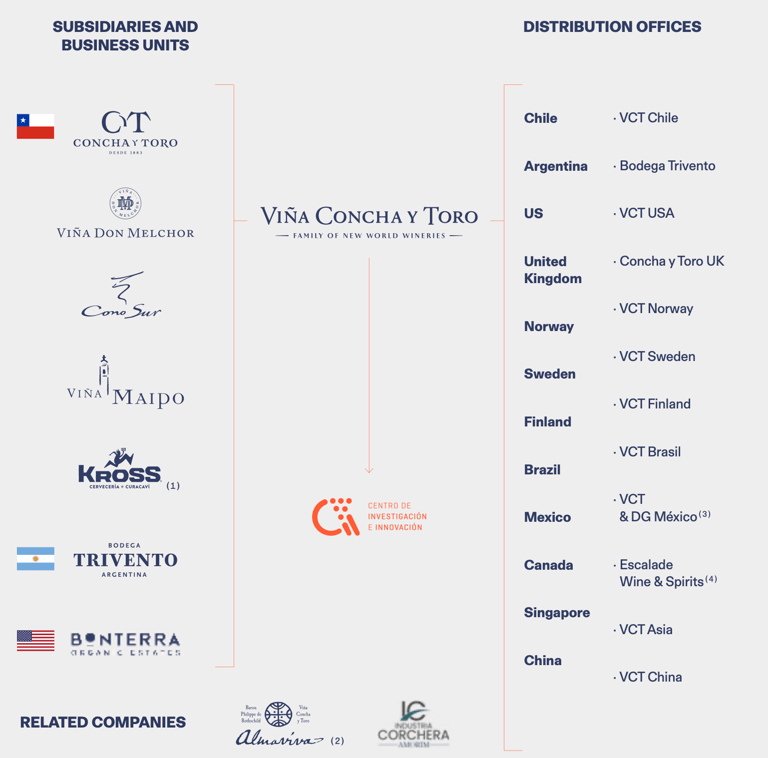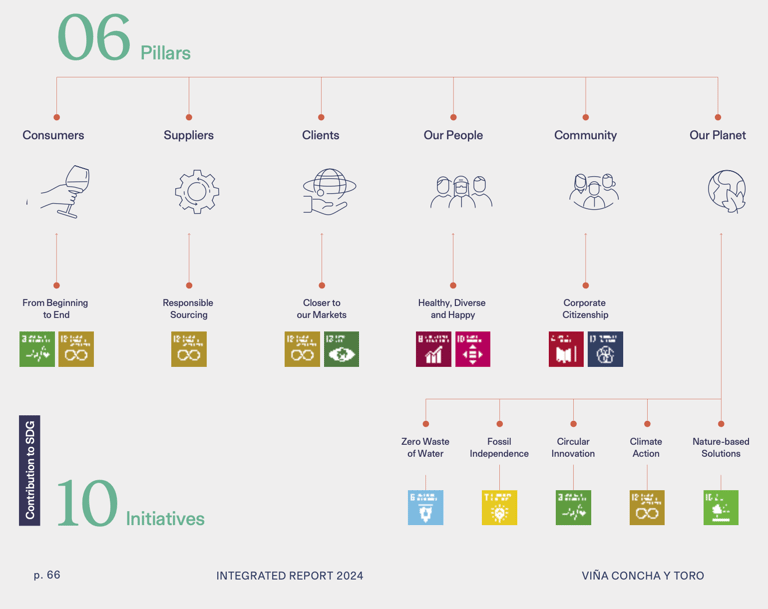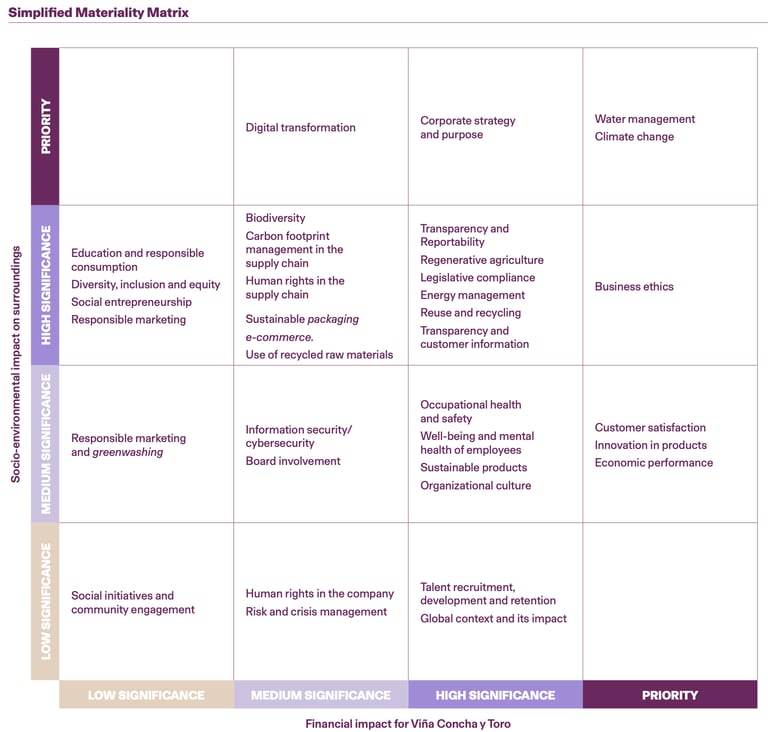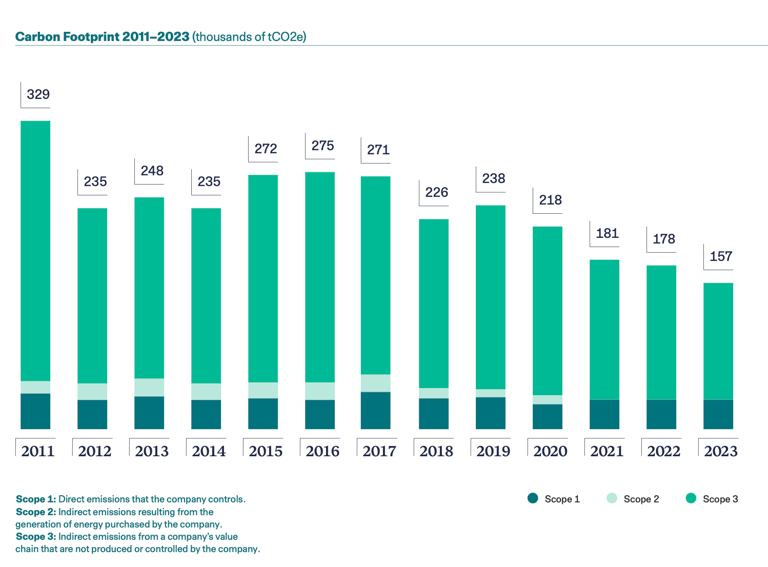Viña Concha y Toro ESG Review 2023
Based in Chile, Viña Concha y Toro is the second largest wine producer with 29.3% market share (as of 2024), and have expanded their markets through acquisitions over the years. Viña Concha y Toro is a publicly traded company that has been around for at least 141 years. Around 2019 the company became the first Chilean company to pledge to commit to the UN 1.5°C ambition. In 2021 they became a certified B-Corp and renewed their B-Corp status in 2024. Their impact report addresses their progress in the financial year 2023.
Viña Concha y Toro is a major player in the Chilean wine industry, accounting for 70% of Chile’s wine exports. Its products are distributed in over 130 countries worldwide, underscoring its global reach and logistical capacity. In Chile, Viña Concha y Toro manages more than 10,000 hectares of vineyards and operates extensive facilities that include 13 wineries for vinification and ageing—12 under the Concha y Toro brand and one under Cono Sur—as well as three bottling plants. The company also maintains 12 commercial offices and distribution subsidiaries in North America, South America, Asia, and Europe.
Viña Concha y Toro seems to have a vertical integration approach in their business operations as they have control in every stage of the production process from the viticulture, to the vinification in its cellars, to the process of bottling, distributing, marketing and selling the finished product, and R&D done in their Centre for Research and Innovation. Aside from wine, they also diversified their products to Pisco, whisky and beer (by acquiring companies specialising in beer). Their subsidiaries often have their own vinification, ageing, and bottling facilities to serve local and global markets. Their broad range of activities involves layers in their ESG analysis.


Image Source: Viña Concha y Toro Impact Report 2024, page 44
ENVIRONMENTAL
Energy Use: Since 2022, Viña Concha y Toro’s operations in Chile, Argentina, and the United States have been powered by 100% renewable energy, achieved either through internal measures or through purchased contracts with third-party verification of renewable energy consumption. However, the company continues to use fossil fuels in agricultural machinery. To address this, it launched the Fossil Independence Program, which aims to reduce fossil fuel consumption by 50% from internal sources. This includes the introduction of electric motorcycles to replace fossil fuel-powered vehicles within facilities, the electrification of machinery and equipment, and the development of lower-energy consumption alternatives for transportation. A key focus of the program is the progressive elimination of diesel-powered equipment at the company’s facilities, such as generators primarily used in the winemaking process.
Climate Action Programme: Viña Concha y Toro measures its carbon footprint in accordance with the GHG Protocol and follows the recommendations of the Task Force on Climate-related Financial Disclosures (TCFD), with all emissions data externally verified. The company has had a carbon reduction pathway in place since 2017 and has since accelerated its targets, bringing forward its net-zero commitment by ten years, from 2050 to 2040. As of 2020, the company reports zero emissions from Scope 2. In the most recent reporting year, Scope 1 emissions declined by 0.2%, while Scope 3 emissions saw a more significant decrease of 14.5%, a result partly attributed to high inventory levels in 2022 which led to reduced boiler use. Overall, greenhouse gas emissions in 2023 are 42% lower than in the base year 2017.
Water Use and Water Efficiency: Since 2010, the company has been tracking its water footprint using the Water Footprint Network methodology, which has revealed that its water footprint is 40% lower than the global wine industry average. Operating in high water-stress regions, Viña Concha y Toro considers water a major environmental risk and has made it a priority area for innovation. The company has developed SmartAgro, a digital agricultural management platform that delivers precise irrigation recommendations, enabling water use reductions of up to 18%. It has also set a target to reduce water consumption per bottle of wine by 10%, from vineyard to final destination. In addition, the company has incorporated water-efficient equipment throughout its operations. Its commitment to water stewardship has been recognized with an A- rating from CDP Water Security, placing it in the “Leadership” category.
Waste Management: Viña Concha y Toro recovers 99% of the production waste it generates, and most of this waste is repurposed or recycled. Of the company’s total waste, 93% originates from the winemaking process, and 94% of that is organic. This organic material is primarily composted and later used to enrich the soil in the vineyards. Additionally, grape skins and seeds from the winemaking process are recovered and used to produce a powder rich in antioxidants and dietary fiber, or to create organic ink. In bottling plants, the majority of waste is industrial in nature and is also recycled. Materials such as glass, plastic, cardboard, and wood are handled by authorized recycling companies. Other materials are creatively repurposed where possible, for example, by making furniture out of old barrels.
SOCIAL
Workforce and Stakeholders: Viña Concha y Toro operates with a workforce of 3,266 employees, serving 19,348 customers and collaborating with 4,223 suppliers across its operations. The company places significant emphasis on its human capital and stakeholder network as part of its broader sustainability and governance commitments.
Employees Training and Development: All employees receive onboarding and continuous training across a range of business areas. The training extends to emerging areas of risk and opportunity to ensure that employees are equipped to adapt to evolving challenges. Staff are encouraged to take part in various training programs, including leadership and administrative training, which incorporates topics like cyber protection. Other available programs focus on harvesting, language skills, workplace conduct, and winemaking, ensuring that both technical and behavioral skills are developed throughout the organization.
Employee Welfare and Inclusion: Viña Concha y Toro supports the wellbeing of its workforce through a comprehensive approach that includes its Recruitment and Selection Policy and the Healthy, Diverse and Happy Programme. Employees have access to healthcare services, sports and recreational activities, and benefit from policies that promote inclusion, gender balance, and multiculturalism, as outlined in the company’s Diversity and Inclusion Policy. In addition to these initiatives, employees can benefit from bonuses and discounts related to healthcare, fitness, and leisure. Robust health and safety measures are in place to ensure a secure and supportive working environment.
Employee Equality: The company demonstrates a commitment to equality by publishing detailed data on the demographics of its workforce, excluding seasonal workers, alongside information on salary gaps. Equality measures include the provision of postnatal leave for both men and women, reflecting an inclusive approach to family and work-life balance.
Responsible Sourcing Programme: Viña Concha y Toro actively works to improve the sustainability practices of its suppliers through its Responsible Sourcing Programme. This initiative is designed to identify, evaluate, and enhance supplier practices, providing tools and guidance to facilitate adoption. A significant component of the program includes the implementation of science-based CO₂ reduction plans. To date, 27 packaging suppliers have transitioned to the Science-Based Targets (SBT) methodology, collectively contributing to the reduction of at least 12,000 tCO₂e within the supply chain. Supplier evaluations are based on criteria such as employment rights, health and safety, environmental impact, and business ethics. The company has developed formal supplier evaluation policies aimed at measuring sustainability across key areas. In 2024, 80% of purchases were analyzed, and 333 significant suppliers—representing 13% of the total—were assessed. Environmental criteria include the carbon footprint of inputs, while social evaluations are based on self-assessments of human rights principles within the supplier organizations.
Community Engagement and Support: Viña Concha y Toro plays an active role in supporting local communities, with a focus on education, environmental awareness, and recreation. A key area of impact is early childhood education, where the company has supported 24 preschools and created family centers and libraries that benefit 1,500 families and 250 teachers. In collaboration with teachers and parents, the company helps transfer essential skills that contribute to long-term child development. The community engagement strategy focuses initially on three key zones: Pirque, Chimbarongo, and Lontué. The program includes proactive communication with neighboring communities, effective complaint resolution processes, and capacity-building initiatives. As part of its environmental contributions, the company has donated 2,000 native trees to residents of Quirihue in the Itata zone of the Ñuble Region, contributing to local reforestation efforts.
Consumer Awareness and Responsible Consumption: Through its “Enjoy Responsibly from Start to Finish” campaign, relaunched in 2021, Viña Concha y Toro promotes responsible consumption of its products among employees, customers, and suppliers. The campaign provides guidance on moderate wine consumption, educates on proper serving sizes, and reinforces non-consumption among vulnerable groups such as minors, pregnant individuals, and drivers. The initiative also includes advice for avoiding harmful drinking behaviors. The company’s Pirque Tourism Centre actively collaborates with associations to support and expand actions related to the responsible consumption of wine and alcoholic beverages.
GOVERNANCE
Supply Chain Governance and Due Diligence: Viña Concha y Toro applies strict due diligence procedures to its supply chain, particularly in its procurement of outsourced grapes from third parties. The company works with several recognized standards and engages in third-party partnerships to ensure the ethical treatment of labor throughout its operations. To reinforce this commitment, key suppliers are subject to regular reviews and audits, enabling the company to monitor compliance with its ethical and sustainability expectations across the value chain.
Codes of Conduct and Ethics Framework: The company maintains a comprehensive Code of Conduct and Ethics, which applies to both employees and customers. This framework is supported by a certified Crime Prevention Model, which has undergone third-party verification. Employee training on the Crime Prevention Model is integrated with a communications program that reinforces key elements such as the Code of Conduct and Ethics, the Whistleblower Channel, and corporate values. It also addresses related policies, including the Conflict of Interest Policy, the Engagement with Public Officials Policy, and the Policy on Gifts and Invitations, among others. These efforts contribute to a strong culture of integrity, transparency, and accountability within the organization.
Risk Management and Compliance: Risk management is a central pillar of Viña Concha y Toro’s governance strategy. The company operates under a Corporate Risk Management Policy and utilizes recognized standards for comprehensive risk analysis and mitigation. This structured approach ensures that the organization can proactively manage emerging threats while maintaining operational resilience and regulatory compliance.
Digital Governance and Innovation: To strengthen operational transparency and efficiency, Viña Concha y Toro continues to invest in digital capabilities. These tools enhance not only employee productivity but also the traceability and efficiency of the supply chain and winemaking processes. One of the company’s flagship digital initiatives is SmartAGRO, a smart agriculture platform that leverages data and technology to optimize resource use and improve sustainability outcomes across its vineyards. These digital advancements also contribute to the company's broader governance goals, including measurable improvements in its digital footprint.
Sustainability Governance and Strategic Oversight: In 2021, Viña Concha y Toro’s board unanimously approved a principle of generating a positive impact on people and the planet, a commitment that now guides the CEO and company leadership. This strategic framework is understood and adopted by subsidiaries, aligning group-wide operations under a unified sustainability vision. The company’s sustainability governance structure includes a dedicated Sustainability Management Team and an Ethics and Sustainability Committee, the latter composed of board members. This ensures that sustainability issues are elevated to the highest levels of corporate oversight.
Board Transparency and Remuneration: Board governance is characterized by transparency in both composition and activities. The company discloses that the remuneration of the board accounts for 1.3% of net income, offering a clear metric for stakeholder evaluation. The presence of a board-level committee dedicated to ethics and sustainability further underscores the company's commitment to responsible leadership and long-term value creation.
Whistleblower Policy and Stakeholder Access: Viña Concha y Toro maintains a Whistleblower Policy that is accessible to all employees and external stakeholders. The policy and associated reporting mechanisms are available on the company’s website, ensuring that concerns related to ethics, misconduct, or compliance can be reported safely and anonymously when needed.
Materiality and ESG Integration: The company conducts a double materiality analysis every two years to assess the financial relevance of environmental and social issues, as well as its broader impact on people and the planet. This structured assessment supports the integration of ESG factors into strategic planning and risk management, ensuring that the company remains aligned with evolving stakeholder expectations and regulatory requirements.Outsourced grapes from 3rd party involves due diligence. They have in their employ several standards and third-party due diligence partnerships to ensure ethical labor in their supply chain. They also carry out reviews and audits on their key suppliers.
Viña Concha y Toro's 'Uncork a Better Future' Corporate Sustainability Strategy




Image Source: Viña Concha y Toro Impact Report 2024, page 106


Image Source: Viña Concha y Toro Impact Report 2024, page 117


Image Source: Viña Concha y Toro Impact Report 2024, page 153
Packaging: In response to the environmental impact of glass, Viña Concha y Toro has systematically worked to incorporate lighter bottle formats into its packaging. The company continues to refine bottle design and prototype increasingly lightweight glass bottles to reduce its environmental footprint. Currently, 43% of the glass bottles used are recycled.
Land use, and use change and forestry (LULUCF): Through its Nature-based Solutions Programme, Viña Concha y Toro has implemented a wide range of biodiversity-supporting practices. These include the establishment of pollinator-friendly gardens, the installation of nesting boxes for birds, and the creation of ponds and fountains for small mammals. In addition, the company has planted cover crops in 100% of its vineyards in Chile. Since 2019, the company has been certified by the Forest Stewardship Council (FSC) for sustainable forest management. This certification supports the conservation of 4,272 hectares of native forest on the company’s estates and has contributed to the planting of 25,000 native trees.
Regenerative Agriculture and Soil Protection: The company invests in regenerative agricultural practices to support soil health and biodiversity. These include the use of cover crops between vineyard rows, controlled livestock grazing, and the incorporation of microorganisms into the soil. Research and development efforts are directed toward optimizing composting practices and determining the carbon stock held in soils, further strengthening the company’s sustainability credentials in vineyard management.
Author's Notes
The report is well-presented and clearly categorised, making it easy to follow. The analysis was based on their consolidated impact report with reference to individual reports from their sustainability strategy. It is clear from their transparency that they are a leader in ESG performance in the wine industry. A few notes about their reporting we would like to see on their next report:
Presentation: The generous use of spacing could be reduced to enhance readability and make the report more compact. Some repetition—such as on page 150—could also be streamlined for conciseness.
Consistency of data provided: i) Data comparisons would benefit from greater consistency. For example, reductions in water use and fossil fuel consumption are compared to 2020, and CO₂ emissions are compared to base year 2020. Using the same baseline across metrics would make it easier for readers to analyse performance trends. ii) There is some ambiguity around the roles of the Board Committee and the Ethics and Sustainability Committee concerning updates and meetings from the Sustainability Management Team. These responsibilities appear to overlap or conflict between page 78 and page 81. iii) Waste is identified as a key environmental concern in the report (page 150), yet it does not appear on the materiality matrix. Including it in future updates would help align declared priorities with stakeholder expectations. iv) The structure of the company—with many subsidiaries and affiliates—adds complexity to its operations. While full reporting across all entities may not be feasible due to varying ownership levels, clearer data presentation would help readers grasp how each segment functions. For example, while postnatal leave statistics are provided across all operational bases, other indicators—such as employee demographics and training—are consolidated. Disaggregated data or visual tools like infographics could improve transparency and enable meaningful comparisons.
Areas where more information is needed: i) The company’s research centre has reportedly developed resilient plants that are more adaptable to climate change and resistant to viruses and trunk diseases. While promising, it would be valuable to understand what this means in ecological terms—particularly regarding yield performance, soil management, and fertiliser use. ii) As Viña Concha y Toro expands into non-wine beers and spirits through subsidiaries, more detailed reporting on these operations will be necessary to understand their broader ESG footprint. iii) On diversity and inclusion, workforce demographics are currently reported only as 'men' and 'women'. To align with best practices in DEI, it would be advisable to add an additional category or side note for individuals who do not identify with either label.
Disclosure
This website does not send email alerts, newsletters, or unsolicited subscription requests. All contact is initiated through the contact form, which enables direct communication via personal email for those who wish to engage further.
All users are encouraged to read our Terms and Conditions
